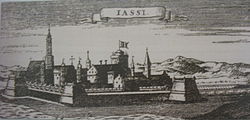Iași
Iaşi is a city in the northeastern part of Romania. It is the second largest city in Romania as of the year 2007.[8] Iaşi used to be the capital of Moldavia.
|
Jassy Iassy | |
|---|---|
 | |
|
| |
| Coordinates: 47°09′25″N 27°35′25″E / 47.15694°N 27.59028°ECoordinates: 47°09′25″N 27°35′25″E / 47.15694°N 27.59028°E | |
| Country | |
| County | |
| Status | Municipality |
| Settled | Before 14th century |
| First official record | 1408 |
| Government | |
| • Mayor | Mihai Chirica (Independent) |
| Area | |
| • County Seat | 93.9 km2 (36.3 sq mi) |
| • Metro | 808 km2 (312 sq mi) |
| Elevation | 60 m (200 ft) |
| Population (2011 census)[6] | |
| • County Seat | 290,422 |
| • Estimate (2016)[7] | 362,142 |
| • Density | 3,092/km2 (8,010/sq mi) |
| • Metro | 474,035[5] |
| Time zone | UTC+2 (EET) |
| • Summer (DST) | UTC+3 (EEST) |
| Postal Code | 700xxx |
| Car Plates | IS |
| Climate | Dfb |
| Website | www |
History
Alexandru Lăpuşneanu changed the capital of Moldavia from Suceava to Iaşi in 1564. One of the first churches to be built in Moldavia was built by the Greek adventurer Prince Ioan Iacob Heraclid.
The Tatars burned the city down in 1513. The Ottoman Empire also burned the city down in 1538 and people from the Imperial Russian army did so again in 1686. The plague spread throughout the city in 1734.
The Russo-Turkish War of 1787 was stopped when the Peace of Iaşi happened. Alexander Ypsilanti and the Filiki Eteria came into the city and took it in 1822.
Iaşi was the capital of Moldavia from 1568 to 1859. When World War I happened, Iaşi became the capital of Romania. This happened when the Central Powers took Bucharest on 6 December 1916. Bucharest became the capital again when Imperial Germany was defeated.
Geography
Iaşi can be found on the Bahlui River, which is a tributary of the Jijia. Forests and uplands are very common. These woods and hills include the monasteries of Cetăţuia, Frumoasa, and Galata. People have thought that Iaşi was built on seven hills (Cetăţuia, Galata, Copou-Aurora, Bucium-Păun, Şorogari, Repedea and Breazu in Romanian).
Population
The population of Iaşi has changed a bit over the years:
Sister cities
The following are the sister cities of Iaşi:
 Chişinău, Moldova.
Chişinău, Moldova. Assiut, Egypt.
Assiut, Egypt. Atlanta, United States.
Atlanta, United States. Filacciano, Italy.
Filacciano, Italy. Forano, Italy.
Forano, Italy. Ilioupoli, Greece.
Ilioupoli, Greece. Isfahan, Iran.
Isfahan, Iran. Jericho, Palestine.
Jericho, Palestine. Ramleh, Israel.
Ramleh, Israel. Kozani, Greece.
Kozani, Greece. Monterrey, Mexico.
Monterrey, Mexico. Morlupo, Italy.
Morlupo, Italy. Nazzano, Italy.
Nazzano, Italy. Padua, Italy.
Padua, Italy. Peristeri, Greece.
Peristeri, Greece. Poitiers, France.
Poitiers, France. Rhodes, Greece.
Rhodes, Greece. Quebec City, Canada.
Quebec City, Canada. Sant'Oreste, Italy.
Sant'Oreste, Italy. Torrita Tiberina, Italy.
Torrita Tiberina, Italy. Villeneuve d'Ascq, France.
Villeneuve d'Ascq, France. Vinnytsia, Ukraine.
Vinnytsia, Ukraine. Xi'an, China.
Xi'an, China.
Iași Media
An 1871 Romanian telegraph stamp, using the historic name of Jassy
Coat of arms of the Principality of Moldavia at Cetățuia Monastery
Great Synagogue (1671)
References
- ↑ "1000 lei 1998 – 80th anniversary of the Great Union of 1918". Romanian Coins.org. Retrieved 24 September 2016.
- ↑ "Iași, the cultural city" (in Romanian). Archived from the original on 2 August 2012. Retrieved 24 September 2016.
{{cite web}}: CS1 maint: unrecognized language (link) - ↑ "About Iaşi" (in Romanian). La Iaşi. 2002. Retrieved 24 September 2016.
{{cite web}}: CS1 maint: unrecognized language (link) - ↑ "Romanian Cities" (in Romanian). Tarom. Archived from the original on 2011-03-05.
{{cite web}}: CS1 maint: unrecognized language (link) - ↑ "Population on 1 January by age groups and sex - functional urban areas". Eurostat. Retrieved 29 October 2017.
- ↑ "Population at 20 October 2011" (in Romanian). INSSE. 5 July 2013. Archived from the original on 10 June 2017. Retrieved 4 May 2015.
{{cite web}}: CS1 maint: unrecognized language (link) - ↑ "Populaţia României pe localitati la 1 ianuarie 2016" (in Romanian). INSSE. 6 June 2016. Archived from the original on 2017-10-27. Retrieved 27 October 2017.
{{cite web}}: CS1 maint: unrecognized language (link) - ↑ 8.0 8.1 "Populatia la 1 iulie 2007" (in Romanian). National Institute of Statistics. 2007-07-01. Retrieved 2008-04-30.
{{cite web}}: CS1 maint: unrecognized language (link)[dead link] - ↑ "Romania in cifre (see page 9)" (PDF). Archived from the original (PDF) on 2008-05-29. Retrieved 2009-01-13.
- ↑ http://www.insse.ro/cms/files/statistici/comunicate/alte/Comunicat%20ziua%20populatiei%202006%20doc.pdf
Other websites
| Wikimedia Commons has media related to Lua error in Module:Commons_link at line 62: attempt to index field 'wikibase' (a nil value).. |
- Iasi City Hall website
- (in Romanian) Official site of the Iaşi police inspectorate Archived 2011-06-21 at the Wayback Machine
- Events in Iaşi Archived 2010-12-25 at the Wayback Machine
- Iasi Map Archived 2014-05-02 at the Wayback Machine











